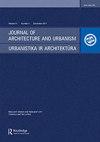ARCHITECTURAL MEMORY AND FORMS OF ITS EXISTENCE
IF 0.8
0 ARCHITECTURE
引用次数: 2
Abstract
The article attempts to highlight the traces of memory in the theory, history and practice of architecture. The subject of research is the existing forms of memory in architecture. It is traditionally accepted that the “history of architecture” as a science is the main repository of knowledge about the evolution of architecture. Facts and artifacts, descriptions of monuments and cities are retained in it. The article emphasizes that the traditional “history of architectural objects” is not the only form of memory. Another equally important and complicated aspect of the architectural memory is detected during the decoding of the evolution of project activity and its language. Analysis of the evolution of architecture allowed us to differentiate the epochs in which historical thinking prevails: the Renaissance, Romanticism, Eclecticism, Art Deco, Postmodernism. They are characterized by such ways of thinking as dialogical, historical and typological, historical and associative. They are opposed to design approaches in which abstract thinking dominates (Art Nouveau and Modernism). The article shows that the concept of architectural memory has many shades and manifests itself in a variety of different forms of professional consciousness. As historical knowledge, memory exists in such forms as: a chronological description, science of history, evolutionary studies, catalog of styles, museum, archive. In designing and its language, memory is represented in such forms as canon, dialogue with bygone era, norm, architectural fantasy, remembrance, historical association, reconstruction, restoration and others. It is shown that the most important way of storing and transferring information is the architectural language and compositional logic. Postmodern consciousness raised the problem of loss of memory and the development of architectural language and communication of culture.建筑的记忆及其存在形式
文章试图突出记忆在建筑理论、历史和实践中的痕迹。研究的主题是记忆在建筑中的存在形式。传统上,人们认为“建筑史”是一门科学,是建筑演变的主要知识宝库。书中保留了事实和文物,纪念碑和城市的描述。文章强调,传统的“建筑物件的历史”并不是记忆的唯一形式。建筑记忆的另一个同样重要和复杂的方面是在解码项目活动及其语言的演变过程中发现的。对建筑演变的分析使我们能够区分历史思想盛行的时代:文艺复兴时期、浪漫主义时期、折衷主义时期、装饰艺术时期、后现代主义时期。它们的思维方式具有对话性、历史性与类型性、历史性与联想性等特点。他们反对抽象思维占主导地位的设计方法(新艺术和现代主义)。文章认为,建筑记忆的概念具有多种内涵,表现为多种不同形式的专业意识。作为历史知识,记忆以以下形式存在:时间顺序描述、历史科学、进化研究、风格目录、博物馆、档案。在设计及其语言中,记忆表现为规范、与过去时代的对话、规范、建筑幻想、记忆、历史联想、重建、修复等形式。研究表明,建筑语言和组合逻辑是存储和传递信息的最重要的方式。后现代意识提出了记忆缺失的问题,以及建筑语言和文化传播的发展问题。
本文章由计算机程序翻译,如有差异,请以英文原文为准。
求助全文
约1分钟内获得全文
求助全文
来源期刊

Journal of Architecture and Urbanism
ARCHITECTURE-
CiteScore
1.30
自引率
14.30%
发文量
12
审稿时长
15 weeks
期刊介绍:
The Journal of Architecture and Urbanism publishes original research on all aspects of urban architecture.
 求助内容:
求助内容: 应助结果提醒方式:
应助结果提醒方式:


